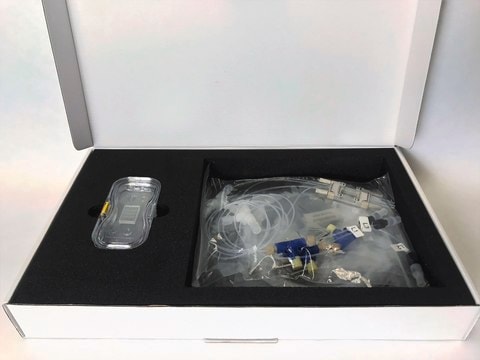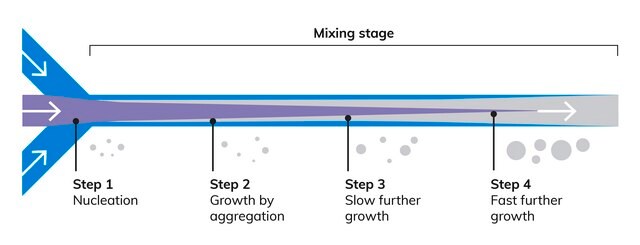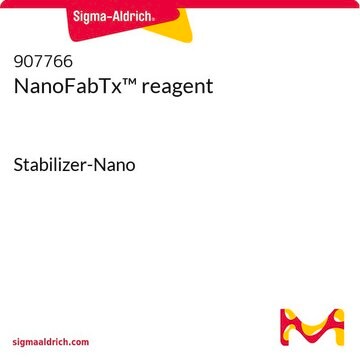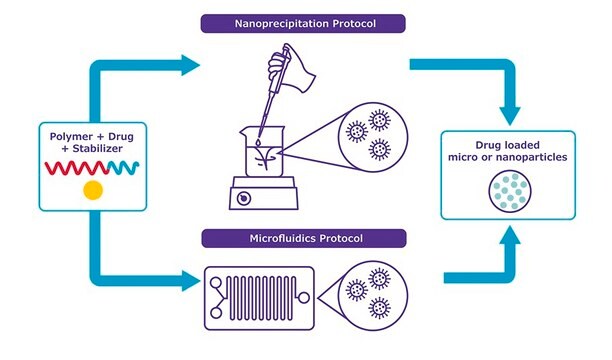918075
NanoFabTx™ PLA-nano
for synthesis of 100 and 200 nm particles
Sinonimo/i:
For nanoparticle synthesis for drug delivery
Autenticatiper visualizzare i prezzi riservati alla tua organizzazione & contrattuali
About This Item
Codice UNSPSC:
12161503
NACRES:
NA.23
Prodotti consigliati
Categorie correlate
Descrizione generale
The NanoFabTx™ Polymer drug formulation kit, PLA, for synthesis of 100 and 200 nm particles is a ready-to-use nanoformulation kit for the synthesis of drug-encapsulating PLA-based nanoparticles. This kit provides properly selected PLA based polymers, stabilizer, and protocols for fabrication of PLA nanoparticles by both nanoprecipitation and microfluidic-based synthesis. The microfluidics protocol uses a NanoFabTx™ device kits (911593, sold separately), which provide all the microfluidics chips, fittings, and tubing required to get started with microfluidics-based synthesis (compatible microfluidics system or syringe pump required).Comprehensive protocols for two different particle synthesis methods are included:
- A nanoprecipitation protocol to prepare drug-encapsulated nanoparticles in standard laboratory glassware.
- A microfluidics protocol using commercial platforms or syringe pumps.
Applicazioni
The NanoFabTx™ Polymer drug formulation kit, PLA, for synthesis of 100 and 200 nm particles enables users to encapsulate a wide variety of therapeutic drug molecules in PLA-based nanoparticles. Drug encapsulated nanoparticles synthesized with the NanoFabTx™ kits are suitable for biomedical research applications such as oncology, immuno-oncology, gene delivery, antigen delivery, and vaccine delivery. Poly(D,L-lactic acid) (PLA) is a biocompatible and biodegradable polymer that has been approved by the FDA for biomedical and pharmaceutical applications. Because of their robust mechanical properties and slow degradation, PLA based nanoparticles have been widely used as drug delivery systems to achieve controlled drug release for different types of therapeutic molecules. This kit minimizes laboratory setup with optimized protocols and step-by-step instruction for synthesizing drug-encapsulated nanoparticle-based formulations. It is designed to help pharmaceutical researches achieve reproducible synthesis with high loading efficiencies without the need for lengthy trial-and-error optimization.
Caratteristiche e vantaggi
- Ready-to-use nanoformulation kit for PLA nanoparticles
- Step-by-step protocols developed and tested by our formulation scientists
- Flexible synthesis tool to create uniform and reproducible nanoparticles
- Optimized to make nanoparticles 100–200 nm nanoprecipitation or microfluidics with low polydispersity
- Based on non-toxic, biodegradable polymers
Note legali
NANOFABTX is a trademark of Sigma-Aldrich Co. LLC
Prodotti correlati
N° Catalogo
Descrizione
Determinazione del prezzo
Codice della classe di stoccaggio
11 - Combustible Solids
Scegli una delle versioni più recenti:
Certificati d'analisi (COA)
Lot/Batch Number
It looks like we've run into a problem, but you can still download Certificates of Analysis from our Documenti section.
Se ti serve aiuto, non esitare a contattarci Servizio Clienti
Possiedi già questo prodotto?
I documenti relativi ai prodotti acquistati recentemente sono disponibili nell’Archivio dei documenti.
S Freiberg et al.
International journal of pharmaceutics, 282(1-2), 1-18 (2004-09-01)
Polymer microspheres can be employed to deliver medication in a rate-controlled and sometimes targeted manner. Medication is released from a microsphere by drug leaching from the polymer or by degradation of the polymer matrix. Since the rate of drug release
Verónica Lassalle et al.
Macromolecular bioscience, 7(6), 767-783 (2007-06-02)
The controlled release of medicaments remains the most convenient way of drug delivery. Therefore, a wide variety of reports can be found in the open literature dealing with drug delivery systems. In particular, the use of nano- and microparticles devices
Nazila Kamaly et al.
Chemical Society reviews, 41(7), 2971-3010 (2012-03-06)
Polymeric materials have been used in a range of pharmaceutical and biotechnology products for more than 40 years. These materials have evolved from their earlier use as biodegradable products such as resorbable sutures, orthopaedic implants, macroscale and microscale drug delivery
Byung Kook Lee et al.
Advanced drug delivery reviews, 107, 176-191 (2016-06-06)
Poly(d,l-lactic acid) (PLA) has been widely used for various biomedical applications for its biodegradable, biocompatible, and nontoxic properties. Various methods, such as emulsion, salting out, and precipitation, have been used to make better PLA micro- and nano-particle formulations. They are
Global Trade Item Number
| SKU | GTIN |
|---|---|
| 918075-1KT | 4065266037296 |
| 918075-1EA | 4061841823162 |
Il team dei nostri ricercatori vanta grande esperienza in tutte le aree della ricerca quali Life Science, scienza dei materiali, sintesi chimica, cromatografia, discipline analitiche, ecc..
Contatta l'Assistenza Tecnica.





